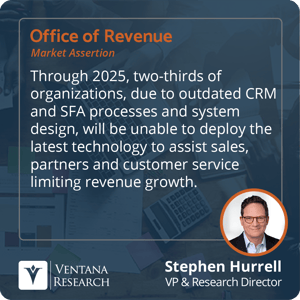I have been involved with customer relationship management for over 15 years, and although that is not as long as the category has been around, it does coincide with an era where companies and commentators are calling into question the application’s effectiveness. To counter this perception, both CRM vendors and complementary third-party “add-ons” have developed new functionality that aims to improve the “R” in CRM, especially as it relates to sales engagement. But much of this additional functionality is dependent on the quality of the original base data – whether it’s facts about a customer, prospect of products or, if not more important, when, how and what activities were performed in furtherance of this relationship.
Here lies the problem: The data captured as part of furthering the relationship often encapsulates the signals many of the new capabilities depend upon to deliver additional value. Capabilities built around artificial intelligence and advanced analytics need relatively complete data across customers, products and markets, but also need to be able to “see” what works well and what doesn’t result in the desired outcome.
For many organizations, CRM systems are old and don’t match current business processes. Often, organizations haven’t kept up with functional development, meaning much of the effort to gather this important activity data is still manual. There is an added truism that if users are challenged to find information or have difficulty accessing it the way they need it, there is little incentive to make sure it is there in the first place. We have seen cases where the original CRM implementation no longer reflects current business needs, and users have developed parallel processes to work around the system. There is also the “hero” model, where workers have figured out how to extract data and massage and report on it outside of the CRM system and are lauded for their creativity, with necessity deemed as being the mother of invention. But despite these shortfalls, work still happens. Sales still happen and customers are still served. But the work requires utilizing unnecessary resources, with little opportunity to understand and validate which processes are working and which are not. Or, by sacrificing data-informed analytics to support best practices, rather than relying on hunches, intuition and “gut feel.”
This can lead to limited revenue growth. We believe that through 2025, two-thirds of organizations will be unable to deploy the latest technology to assist sales, partners and customer service due to outdated customer relationship management and sales force automation processes and system design.
outdated customer relationship management and sales force automation processes and system design.
So, what are the options for organizations in this position? One option is to reimplement the existing system. Or, look for a new vendor and reimplement. More likely, organizations do nothing and carry on. We have found that this option is the default choice for a reason: Sales and revenue organizations are quite rightly focused on carrying out a primary role, which is to sell or manage accounts and hit targets. So, if you were to ask, the answer would invariably be, “Not now. Maybe next quarter.”
This situation will not change organically. There are no skunk-works projects or user-led activities that can drive the necessary change. It will require top-down leadership with buy-in and support from the sales and revenue operations team as well as IT business support. But for organizations where business looks markedly different from 10 or even five years ago and the CRM implementation has not evolved accordingly, key decisions will have to be made.
More recently, and with the prospect of a slowdown in demand, many executive teams are more concerned with sustaining business profitability. With the added dimension of mixed pricing models and the impact of omnichannel buyer engagement, understanding the profitability and margin implications at the point of sale are now as important as revenue growth. The current maxim is, “not all dollars are the same.” Reassessment and reimplementation initiatives should ensure that an organization’s CRM system reinforces an integrated approach to prospect and customer engagement, supporting standardization of processes, automatic collection of activity data and visibility to all who are involved in prospects and customers.
From a functional point of view, prices and margins for many organizations should be managed within guardrails at the point of sale via applications such as a configure, price quote, with guidelines based on the differing margins that are dependent on the type of pricing model and sales channel used. Dynamic pricing at the point of order may also be an advantage, depending on the industry. I examine this in my analyst perspective on the importance of CPQ guardrails at the point of sale.
Leaders of revenue and sales teams, in conjunction with the offices of the chief financial officer and chief information officer, need to review CRM implementations regularly, ensuring that as the business evolves, so does the technology supporting the people and processes. And this needs to be an active conversation between the business, IT and the vendor. If the CRM system does not align with changing business models and processes and maximize available functional improvements from the vendor, revenue and finance teams will find themselves increasingly working around the technology, purchasing and adopting unnecessary tools and using additional resources to deal with exceptions and manual work-arounds with wasteful customizations. This will ultimately add costs as well as put the sales team at a competitive disadvantage. Though it’s easier to come up with reasons not to adapt, organizations slow to change will wind up competing not just against other organizations but with internal systems and processes.
Regards,
Stephen Hurrell


 outdated customer relationship management and sales force automation processes and system design.
outdated customer relationship management and sales force automation processes and system design.








